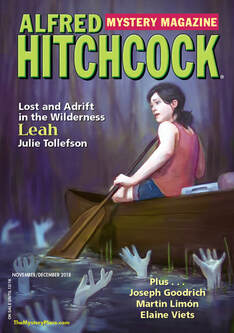|
1/15/2019 0 Comments The Benefits of a Crash and Burn I visit the Pikes Peak Writers blog today with advice about setting writing goals. In The Benefits of a Crash and Burn, I suggest ways to turn a writing failure into writing success. There are dozens of quotes, memes, and greeting card messages about failure making you stronger. That doesn’t help much when you’re crumpled in the ditch after a spectacular crash and burn.
0 Comments
 A rule beginning writers encounter is that multiple points of view can't be used effectively in short stories. The November / December 2018 issue of Alfred Hitchcock Mystery Magazine often publishes multiple POV short stories. Keep in mind that these are written by authors at the top of their game. How does telling a tale through more than one narrator work? Manitoba Postmortem, by S. L. Franklin, not only uses three point of view characters, it also is not told in strict chronological order. Yet I never felt lost. Semi-retired private investigator R. J. Carr opens the story as he and his wife arrive at a police station in Grand Fork, Manitoba. The reader is dropped into the middle of the action, interviewing a Canadian Mountie about a death they have been hired to investigate. A highly esteemed church and community member has apparently committed suicide. Next we are presented Ginny Carr's version of events with the clear demarcation of a scene break and the character's name in bold print. Ginny goes back in time, explaining why she encouraged R. J. to take a case. She presents information that will be vital to solving the mystery. Next up is Teresa Kostner, daughter of the deceased man. Surprisingly, she tells her side of the story without revealing critical facts, and in a manner that did not make me feel cheated. The reader is clued in at the end of her section with the statement, "But I hadn't told too many lies." We hop back to R. J.. The clues are coming together like bits of a jigsaw puzzle finally forming a picture. R. J. pushes the boundaries of the investigation, and becomes trapped in a sticky situation. The final point of view change is back to Ginny. She completes the story. Three point of view characters, with five distinct changes. Each part of the story was told by the different characters for a reason. The reader received vital clues and insights that only that character knew at the time. Robert Lopresti's A Bad Day for Algebra Tests uses multiple points of view in a wild and humorous bank robbery caper. I never felt lost or confused, even though this short story is told through a less than brilliant bank robber, a police officer plagued by bad luck and on the verge of getting fired, a love sick bank manager, two tellers, and a boy upset that a snow day postpones the algebra test for which he studied so hard. Six point of view characters in a not particularly long story is ambitious. Lopresti is a master short story author. Each character's voice is distinct, and the transitions between them is seamless. What makes it a truly great read is that each character has his or her own motivation. I felt I received six stories in one. The complicated plot lands right where the author intended, and the reader never expected. Multiple points of view can be used effectively by skilled writers. Franklin and Lopresti both succeeded because the transitions between POV characters were distinct and purposeful. Each character contributed a different version of events that was necessary to understanding the tale. |
Subscribe to this blog: |
Proudly powered by Weebly
 RSS Feed
RSS Feed